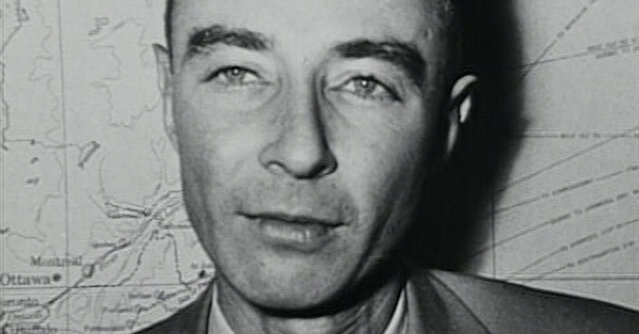
One morning in the 1950s, Jon H. Else’s father pointed toward Nevada from their home in Sacramento. “There was this orange glow that suddenly rose up in the sky, and then shrank back down,” Else recalled.
It was, hundreds of miles away, an atomic weapon test: a symbol of the world that was created when a team of Americans led by the physicist J. Robert Oppenheimer exploded the first nuclear bomb a decade earlier on July 16, 1945.
Growing up in the nuclear age left an impression on Else, now 78.
He was later a series producer of the award-winning “Eyes on the Prize,” a program on the civil rights movement, and directed documentaries about the Great Depression and Wagner’s “Ring” cycle. But before all that, in 1981, he made a documentary about Oppenheimer, the scientist whose bony visage graced the covers of midcentury magazines, and the bomb. It was called “The Day After Trinity,” a reference to that inaugural detonation.
Decades later, viewers are flocking to Else’s film, a nominee for the Academy Award for best documentary feature, as a companion to Christopher Nolan’s biopic “Oppenheimer,” which grossed more than $100 million domestically in its opening week this month.
After the Criterion Channel made “The Day After Trinity” available without a subscription until August, it shot to the top of the streaming service’s most-watched films this month, alongside movies directed by Martin Scorsese, Paul Verhoeven, Michael Mann and other typically Letterboxdcore filmmakers.
“We have seen a huge increase in views,” Criterion said in a statement, “and we’re very happy with the success of the strategy as a way to make sure this film found its rightful place in the conversation around ‘Oppenheimer.’”
In a phone interview from California last week, Else, a professor emeritus at the University of California, Berkeley, praised Nolan’s film, which he saw last weekend in San Francisco. (A spokeswoman for Nolan said he was not available to comment.)
“These stories have to be retold every generation,” Else said, “and they have to be told by new storytellers.”
Nolan’s three-hour opus, a Universal release shot on IMAX film with a lavish cast of brand-name Hollywood actors, shares much with “The Day After Trinity,” an 88-minute documentary financed by the public television station in San Jose, Calif., and various grants.
The Oppenheimer of “Oppenheimer” (based on Kai Bird and Martin J. Sherwin’s Pulitzer Prize-winning biography “American Prometheus”), and the Oppenheimer of “The Day After Trinity” are the same brilliant, sensitive, haunted soul. “This man who was apparently a completely nonviolent fellow was the architect of the most savage weapon in history,” Else said.
The movies feature some of the same characters from the life of Oppenheimer, who died in 1967, including his brother, Frank (played in “Oppenheimer” by Dylan Arnold), his friend Haakon Chevalier (Jefferson Hall) and the physicist Isidor Isaac Rabi (David Krumholtz). Both films build to Trinity and then document the conflict between some of its inventors’ hope that the bomb would never be used in war and its deployment in Japan, the invention of the more devastating hydrogen bomb and the nuclear arms race of the Cold War.
A central plot point in each movie is a closed hearing in 1954 at which Oppenheimer was stripped of his government security clearance, partly because of past left-wing associations. David Webb Peoples, a co-editor and co-writer of “The Day After Trinity” — whose later screenwriting credits include “Blade Runner,” “Unforgiven” and “12 Monkeys” — even proposed structuring the film around the hearing, as Nolan did with “Oppenheimer.”
“The closest he ever came to an autobiography is his personal statement at the beginning of the hearing,” said Else, who focused on interviews with firsthand witnesses, old footage and still photographs rather than trying to recreate the hearing.
“It’s also a courtroom drama,” Else added, “and who is not going to pay attention to a courtroom drama?”
One place “The Day After Trinity” goes that “Oppenheimer” does not is Hiroshima. In the documentary, Manhattan Project physicists recount wandering the wrecked Japanese city. The narrator explains that the Allies had not bombed it beforehand to preserve a place to demonstrate the new weapon.
Else returned to the topic in his 2007 documentary, “Wonders Are Many: The Making of ‘Doctor Atomic,’” which chronicles the composer John Adams’s opera about Oppenheimer. Else is currently working on a book about nuclear testing. And in 1982, he made a one-hour episode of the public-television series “Nova” about the Exploratorium, the San Francisco science museum that was founded in 1969 by none other than Frank Oppenheimer.
“Making ‘The Day After Trinity’ was a pretty rugged ride — it’s pretty rugged subject matter,” Else said. “After I finished it, it was such a joy to spend a year with Robert Oppenheimer’s younger brother, Frank, and celebrate the joy of science.”













